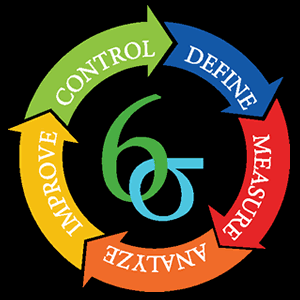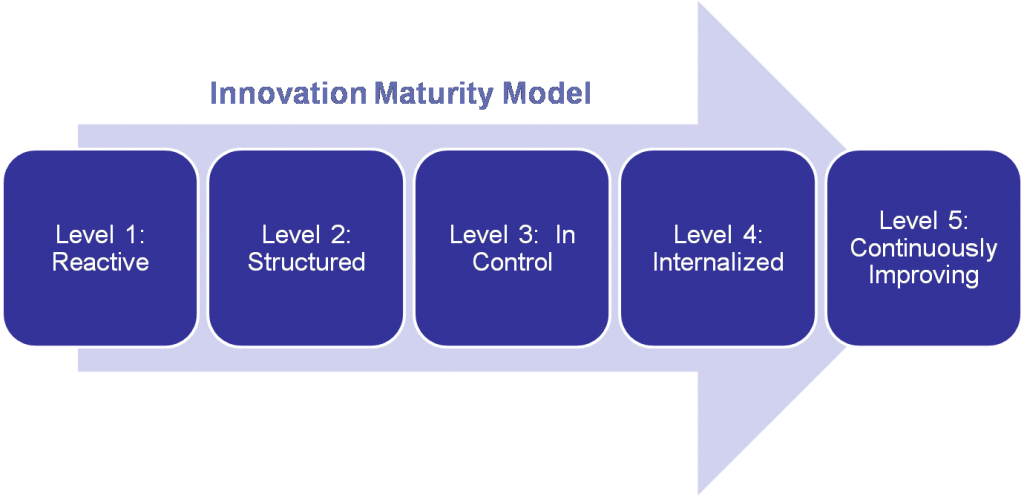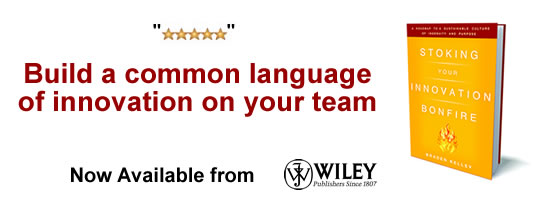 Below is a rough draft of an article I wrote for the current issue of iSixSigma magazine.
Below is a rough draft of an article I wrote for the current issue of iSixSigma magazine.
Can the popular Six Sigma framework be adapted to look at innovation?
Much has been written about how a formal Six Sigma approach and a formal approach to innovation cannot co-exist. But is that really true?
On the surface these two formal approaches personify the natural tension between exploitation and exploration activities within any organization. Six Sigma is generally thought of as an exploitation activity, while innovation is usually associated with exploration. When I speak of exploitation, I’m not speaking of child labor and deforestation, but of optimizing the transformation of organization’s inputs into profitable outputs under its existing business model. And when I speak of exploration, I’m referring to the organization’s efforts to pursue new potential business models, new product or service areas, or both.
Let’s look back before we look forward.
Continue reading the rest of this article on Innovation Excellence
A Brief History
The Six Sigma methodology is celebrating its 25th anniversary this year after being developed by Motorola back in 1986 and popularized by GE and others. As many of you know, Six Sigma began as a methodology focused on improving quality, but over time organizations have adopted and adapted the methodology to encompass activities focused on continuous improvement and on cutting costs.
Innovation meanwhile, dates back nearly 500 years as a term to the Latin innovare which is often interpreted to mean “to renew or change” and the most often referenced godfather of innovation is Joseph Schumpeter (1930). So despite being focused on the new, the philosophy of innovation is actually older than that of Six Sigma.
But, so what?
The people who see innovation and Six Sigma as compatriots and not combatants are correct. This is because in some cases Six Sigma can actually be seen as an innovation approach – but not in every instance.
Say what?
Let’s look at my definition for innovation and then dig a little deeper, and this ambiguity will make more sense:
“Innovation transforms the useful seeds of invention into widely adopted solutions valued above every existing alternative.”
Shared Goals, Different Outcomes
I think we can all agree that both Six Sigma and innovation are focused on creating improvement. However, while Six Sigma is focused on achieving improvement by decreasing variability, innovation is focused on achieving improvement by increasing value. Sometimes an increase in quality through a decrease in variability does create increased value for the customer and sometimes it doesn’t.
Say what?
When would an increase in quality through a decrease in variability not lead to an increase in value for the customer?
Well, one important component of my innovation definition above was the end bit – “valued above every existing alternative – and widely adopted” – which is the real key. New solutions have an obvious increase in value that the inventor always sees, but at the same time they generally have an accompanying decrease in value for the customer that often an inventor fails to see that prevents their solution from being widely adopted (and thus staying an invention instead of graduating to become an innovation).
It is therefore possible for a new solution to deliver increased quality but actually destroy value for the customer – and not be widely adopted as a result. This is why things like the incandescent light bulb and traditional mousetrap stay around for so long despite the introduction of other potential solutions.
Natural Conflict
You should see by now that while Six Sigma and innovation are not mortal enemies at their cores, there are differences that create natural conflicts. This requires managers to be aware and to consciously manage how they are going to use these two approaches together (if at all) in their organizations.
The main tension between the two approaches is that Six Sigma at its core requires accurate measurement. How else will you know whether a Six Sigma project has resulted in decreased variability and a sustainable improvement? On the flip side, the more radical or disruptive an innovation project is attempting to be, the more difficult it will be to accurately measure both the expected risk of the project and the expected profitability and adoption possibilities. A great example of the difficulties of forecasting risk and outcomes is the Segway. Imagine you were in charge of the project back in 2000. How would you size the market for personal transporters? How would you forecast what the media response would be? How would estimate the risks to the project posed by sidewalk regulations? How would you measure consumer readiness accurately? We all know that most forecasts for the new are based on the old, and that this measurement approach is flawed, but it loses all credibility when applied to disruptive innovation projects – and we have to accept that. This inherent uncertainty is why successful innovation is often the result of finding the right questions, while success at Six Sigma is often the result of finding the right measurements.
The mindset created by the need for accurate measurement is congruent with the executive mindset, which brings me to another of my favorite tensions in business – that between the executive mindset and the entrepreneurial mindset. Often not effectively managing this tension, more than any other, prevents organizations from being able to successfully innovate in a sustainable manner. Let’s compare these two mindsets:
- The Executive Mindset – Executives typically are focused on what they can do to avoid failure. Executives tend to focus on doing everything they can to make the trains run on time (so to speak).
- The Entrepreneurial Mindset – Entrepreneurs typically are focused on trying to do whatever they can to create success. Entrepreneurs tend to ask questions like, “Why a train?”
These natural tensions mean that managers have to be careful not to make adoption of Six Sigma methodologies too widespread. Otherwise, there is a real possibility of stifling the un-structured thinking in the more creative areas of the business, such as Design and R&D. This is especially true where the initial stages of idea discovery take place – when partial ideas need to be collected and connected to form strong innovation candidates.
Linking Six Sigma to Innovation
In organizations using Six Sigma and Innovation, there are real opportunities to use the two together. Maybe it is in using Design for Six Sigma (DFSS) in the later stages of your innovation process to ensure that your new products and services deliver the same level of quality as your existing product or service portfolio. Or, with open lines of communication between your innovation and Six Sigma groups, maybe there are opportunities for:
- Six Sigma groups using an expanded methodology focused on continuous improvement to pass interesting improvement ideas that are a bit too radical to be accurately measured, or just a bit too variable. The innovation group, on the other hand, might be able to collect and connect the dots, or to challenge the right other areas of the organization or its partner/supplier/customer ecosystem to find a workable solution.
- Innovation groups enhancing, evaluating or developing ideas might be able to reach out to people in the Six Sigma group for help in either identifying better ways of measuring potential performance of different ideas, or possibly even for help in knocking down certain obstacles that might arise in the commercialization of ideas.
- Six Sigma groups to leverage the innovation group to help them identify solutions that can achieve six sigma results when they can’t identify potential solutions internally capable of producing the requisite level of quality within accompanying tolerances for variability.
DMAIC for Innovation
Given that people have expanded the use of the DMAIC methodology (Define, Measure, Analyze, Improve, and Control) beyond strict use on improving quality and reducing variability to be used on continuous improvement projects, I thought why not stretch it a bit further and create a DMAIC for Innovation. Let’s have a look at what such a creature might look like.
Define
Imagine that you work for an automobile manufacturer and I were to task you with solving the following technical challenge: “How would you make our automobiles use less gasoline?” Think about what your approach would be. Now, some of you might focus on making the automobile lighter, others might focus on making the engine more efficient, still others would focus on making it more aerodynamic, and a few of you would think about ways to make an automobile that ran on something other than gasoline altogether. Ask the innovation question in the wrong way and you will get different innovation results than you expect. Here are some key things to consider:
- Any successful innovation effort begins with a cross-functional innovation leadership team sitting down and defining what innovation means for the organization, establishing a common language, and communicating this out to the organization in a clear manner.
- While it may be good sometimes to have people going off in lots of different directions, that needs to be a conscious choice, otherwise the innovation energy of your organization will dissipate and little will be achieved. You must focus the innovation energy of your organization and that is done by defining what innovation means to your organization and what the common language around innovation will be. At the same time it is important to establish an innovation vision and strategy.
- An innovation vision provides the focus employees need and a vision is about the “where” and the “why,” not the “what” or the “how.” Jack Welch, former CEO of General Electric, once said, “Good business leaders create a vision, articulate the vision, passionately own the vision, and relentlessly drive it to completion.” An innovation vision can help employees answer questions like – “What kind of innovation are we pursuing as an organization?” or “Why should employees, suppliers, partners, and customers be excited to participate?”
- An innovation strategy is not merely agenda for new product development or a technology roadmap from R & D. Instead, an innovation strategy identifies who will drive a company’s profitable revenue growth and sets the innovation direction for an organization toward the achievement of its innovation vision. A well-defined innovation strategy helps the organization define which innovation challenges to focus on and what tactics will best help the organization conquer those challenges. At the same time, it serves as a map to refer back to as projects and ideas are being evaluated, so that ideally a link can be maintained between the organizational strategy and the innovation strategy.
Measure
While it is often harder to estimate the market size for true innovations than it is for line extensions or product improvement projects, it is still important to measure certain things related to innovation. When looking to begin a formal approach to innovation, here are some key measurement questions that need to be asked:
- What are the organizations innovation goals?
- What is the capacity for innovation in your organization?
- What is the organization’s appetite for risk?
- What is the organizations ability to finance innovation projects?
- What is the ability of the organization to be flexible and adaptable?
- How will we measure the success of our innovation program?
- How will we instrument our innovation projects for learning?
Analyze
Innovation requires a great deal of analysis. This includes analyzing what the key insights are that you can drive your ideations off of, analysis of the brand equity and capabilities of the organization that can be leveraged, and analysis of what direct and adjacent competitors are doing now, and analysis of the future strategic actions that we expect our competitors to take. In coming up with these key insights it is useful to use a methodology like Rowan Gibson’s four lenses from Innovation to the Core:
- Challenging orthodoxies: Questioning deeply held dogmas inside companies and inside industries about what drives success.
- Harnessing discontinuities: Spotting unnoticed patterns of trends that could substantially change the rules of the game.
- Leveraging competencies and strategic assets: Thinking of a company as a portfolio of skills and assets rather than as a provider of products or services for specific markets.
- Understanding unarticulated needs: Learning to live inside the customer’s skin, empathizing with unarticulated feelings and identifying unmet needs.
The analysis phase is not, of course, just about generating the insights, but also about generating the ideas. And when it comes to ideas, people don’t realize that often their great idea is actually only a partial idea. So, another important and often underappreciated part of the analysis phase when it comes to innovation is the collection and connection of partial ideas to create potential complete solutions. And, there is also a great opportunity for collaboration during this phase to take the raw ideas and make them better BEFORE the final part of the analysis phase. The crescendo of this phase is the analysis of all of the potential ideas that you could fund, evaluating them using cross-functional teams, and picking which to fund.
Improve
The improve phase is about actually creating the innovation. It’s about getting down to business and beginning to develop the selected ideas. This includes prototyping, market testing, customer feedback, and most importantly – learning and iterating. A key part of this iteration as we discussed earlier is finding the right questions to highlight reasons for potential market success or failure. Embedded in this of course is finding the right answers that will turn a potential invention into a widely adopted innovation success.
But there is another part of innovation that is often under-appreciated, and that is the role of communications. If you are truly bringing an innovation to market, then you are bringing new value to customers that they may not intuitively understand that they have the need for. Too often companies fail at innovation because they ignore the importance of communications:
- Internally to make people inside the organization passionate believers and supporters of the ideas (instead of roadblocks).
- Internally to improve the inputs into the idea development process. How can you contribute to the improvement of an idea if you don’t understand what it is or the magnitude of its impact?
- Externally to either explain the new value for an incremental innovation, or to educate the customer about the value of a disruptive innovation.
Control
Control is of course about making innovation repeatable, sustainable, and successful in the organization. How do you make innovation a deeply embedded capability of the organization? The organization must move from pursuing a firefighting approach to innovation and create a continuous process with organizational commitment at every level. This means that you build a foundation on:
- An organizational psychology with improved tolerance for risk and an understanding that failure is a real possibility, and that instead of avoiding failure, we will seek success and mitigate failure through a portfolio approach and by embedding an ability to learn fast from failure OR success.
- Building an organizational structure and policies that enable resource flexibility and movement of resources to projects where they are needed most.
- Creating a culture and systems that support the free flow of information to employees about customer insights and the value of innovation and amongst employees to enable stronger collaboration on ideas and partial ideas.
- Providing the leadership commitment, the processes and tools, the rewards and recognition, the skills training, and other elements of creating a sustainable innovation process culture.
Conclusion
Six Sigma and innovation can co-exist. They both bring value to the party and while the languages may be somewhat different, it is possible to create a shared vocabulary and a shared understanding of how the two approaches to creating positive business change can work together. It is always a question of finding balance. Find that balance between chaos and structure. Find that balance between exploration and exploitation. Innovation and Six Sigma are not enemies. In fact they have a lot in common. In much the same way that it requires organizational commitment and a professional approach to achieve high levels of quality, it requires organizational commitment and a professional approach to achieve continuous innovation. If you can embed quality into your products, you can embed innovation into your organization.
Happy innovating!
If you’d like to share your thoughts about the intersections or interplay between innovation and six sigma, please sound off in the comments below…
This has been a rough draft of an article I wrote for the current issue iSixSigma magazine – to see the finished version – subscribe.
Sources:
- Kelley, Braden (2010). Stoking Your Innovation Bonfire. USA. Wiley & Sons. ISBN 0470621672
- http://en.wikipedia.org/wiki/Six_sigma
- http://www.businessweek.com/magazine/content/07_24/b4038406.htm (link broken)
- McKeown, Max (2008). The Truth About Innovation. London, UK: Prentice Hall. ISBN 0273719122.
![]() Sign up here to get Human-Centered Change & Innovation Weekly delivered to your inbox every week.
Sign up here to get Human-Centered Change & Innovation Weekly delivered to your inbox every week.

 Can government help companies innovate, or do they tend to get in the way instead?
Can government help companies innovate, or do they tend to get in the way instead? You know how sometimes when you order a product you get this inch-thick instruction manual that you never read, but also how there is sometimes a QuickStart Guide of 5-10 simple steps to get you up and running quickly?
You know how sometimes when you order a product you get this inch-thick instruction manual that you never read, but also how there is sometimes a QuickStart Guide of 5-10 simple steps to get you up and running quickly?





